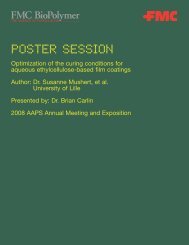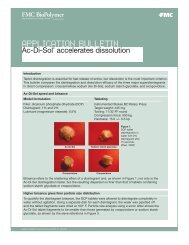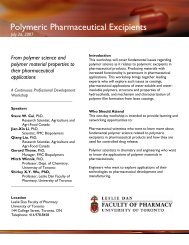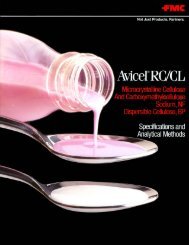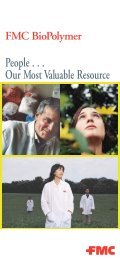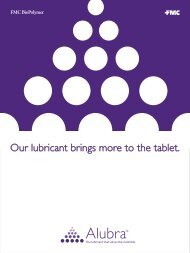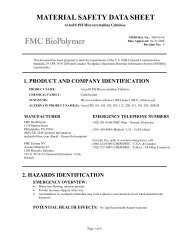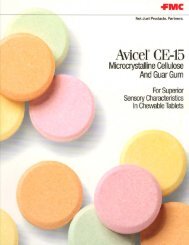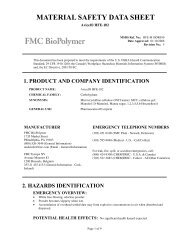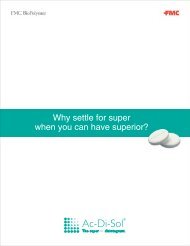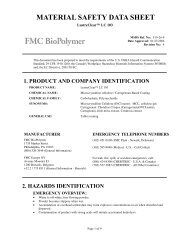PS-Section 11 1/16/07.QXD - FMC BioPolymer
PS-Section 11 1/16/07.QXD - FMC BioPolymer
PS-Section 11 1/16/07.QXD - FMC BioPolymer
- No tags were found...
You also want an ePaper? Increase the reach of your titles
YUMPU automatically turns print PDFs into web optimized ePapers that Google loves.
Figure 2: Cellulosic ProductsPulp CelluloseChemicalDerivatizationMechanicalDisintegrationChemicalDepolymerizationWet MechanicalDisintegrationSolubleCellulose Derivative+ WaterHydrocolloidSolutionFibrousCellulose FlocDryingMicrocrystalline CellulosePowderDispersingAgentColloidalMicrocrystalline Cellulose+ WaterAqueous ColloidImportance of the Commercial Introduction of Avicel PHMicrocrystalline Cellulose to Direct CompressionAvicel ® was introduced by <strong>FMC</strong> in 1964 inselected particle sizes and moisture contentsas an ingredient for direct compressiontableting. The concept of being able to avoidthe costly and time-consuming process ofwet granulation was one that many formulatorshad pursued for years. However, theonly product available at that time that hadbeen designed for direct compression tabletingwas spray dried lactose. Spray dried lactosehad many advantages to recommendits use and indeed it was used to produceproducts by the direct compression manufacturingprocess. It was flowable andrelatively compressible. Unfortunately, spraydried lactose had several problems whichlimited its use. One was a brown color thatdeveloped when used in tablets containingbasic amine drugs, caused by an impurityin the lactose which chemically reacted withamines. Another problem was lumping ofthe lactose in bulk drums on storage. Finally,even though it was compressible, there wereinstances where the compressibility of thelactose could not accommodate high levelsof poorly compressible drugs, and softtablets would result. The suppliers of spraydried lactose recognized these problems andthe products available on today’s market areimproved in these respects over the originalproduct offerings.4
The commercial introduction of Avicel ® in1964 as a direct compression tablet excipientexpanded the usefulness of this methodof tablet manufacture. Combinations ofspray dried lactose and Avicel overcamecompressibility problems while the lactoseadded flowability to the Avicel productsavailable at that time. Direct compressiontableting became a reality, rather than aconcept, because of theavailability of Avicel.The Tableting Characteristics of Avicel PH Microcrystalline CelluloseAvicel can be directly compressed alonewithout the aid of a lubricant at humiditiesless than about 55%. However, above thisvalue, some punch face sticking can beobserved. In formulations, lubrication isalways necessary, although microcrystallinecellulose has been classified as an “antiadherent”and reduction in lubricant concentrationmay be achieved in some formulations.Microcrystalline cellulose is often referred toas having “lubricant sensitivity”. While it istrue that the compressibility of a mixture ofmagnesium stearate and microcrystallinecellulose is less than that of microcrystallinecellulose alone, this reduction in compressibilityhas no practical significance in formulations.“Lubricant sensitivity” is sometimesused as a functional test to evaluate microcrystallinecellulose from several sources.As is the case with lubricants in general,especially the alkaline stearates, the effecton tablet hardness caused by the lubricantis a function of its concentration, mixingtime, and amount of shear induced bythe mixing process itself. Particle size of themicrocrystalline cellulose also influences“lubricant sensitivity”. Avicel PH-200 (180microns) is more sensitive to lubricant thanis Avicel PH-101 (50 microns) because thesame concentration of lubricant more efficientlycovers the larger particle size PH-200than the smaller particle size (larger particlesurface area) PH-101.When compressed, microcrystalline celluloseundergoes plastic deformation. Slip planes,dislocations, and the small size of theindividual crystals all aid in the plastic flowthat takes place. The acid hydrolysis portionof the production process introduces slipplanes and dislocations into the material.The spray dried particle itself, which has ahigher porosity compared to the absoluteporosity of cellulose, also deforms undercompaction pressure. The strength ofmicrocrystalline cellulose tablets resultsfrom hydrogen bonding between theplastically deformed, large surface areacellulose particles. Indeed, a microcrystallinecellulose tablet could be described as acellulose fibril in which the microcrystalsare compressed closely enough togetherso that hydrogen bonding between themoccurs. Microcrystalline cellulose is recognizedas the most compressible of any directcompression excipient, in that less compressionforce is required to produce a tablet ofa given hardness than is required for otherdirect compression materials.One of the functionality tests performed ondirect compression excipients in general,and specifically on Avicel, is “carryingcapacity”. Carrying capacity measures theamount of a drug substance, usually poorlycompressible, that can be added to theexcipient while still obtaining a satisfactorytablet with respect to hardness and/orfriability. The more drug substance that canbe added to the excipient, or alternatively,the less excipient that is needed, the betterthe carrying capacity of the excipient.Typically, 20–25% microcrystalline cellulose5
Figure 4: PH-102 — Used as above but larger particle size improves flow of fine powders.Figure 5: PH-103 — Same particle size as PH-101; reduced moisture content (3%); usedwhere moisture sensitive pharmaceutical active ingredients are present.8
Figure 6: PH-105 — Smallest particle size; most compressible of the PH products; useful indirect compression of coarse, granular, or crystalline materials; can be mixed with PH-101 orPH-102 to achieve specific flow and compression characteristics; has applications in rollercompaction; poorly flowable by itself – cannot determine neat compressibility.Figure 7: PH-<strong>11</strong>2 — Same particle size as PH-102; much reduced moisture content (1.5%);used where very moisture sensitive pharmaceutical active ingredients are present.9
Figure 8: PH-<strong>11</strong>3 — Same particle size as PH-101; much reduced moisture content (1.5%);used where very moisture sensitive pharmaceutical active ingredients are present.Figure 9: PH-200 — Large particle size with increased flowability; used to reduce weightvariation and to improve content uniformity in direct compression formulations and (as afinal mix additive) in wet granulation formulations.10
Figure 10: PH-301 — Same particle size as PH-101 but more dense providing increasedflowability, greater tablet weight uniformity, the potential for making smaller tablets, andimproved mixability; useful as a capsule filling excipient.Figure <strong>11</strong>: PH-302 — Same particle size as PH-102 but more dense providing increasedflowability, greater tablet weight uniformity, the potential for making smaller tablets, andimproved mixability; useful as a capsule filling excipient.<strong>11</strong>
Avicel ® PH Microcrystalline Cellulose Functionalityin the Wet Granulation Manufacturing ProcessIt is well known that the wetting of neatmicrocrystalline cellulose with water, followedby drying and tablet compression,results in tablets of lower hardnesses thanare obtained by compression of neat microcrystallinecellulose without prior treatment.This procedure would be expected to notonly reduce the density of the particleagglomerates themselves thereby decreasingtheir internal surface area, but also wouldcause some adhesion between particleagglomerates, reducing external surfacearea as well. Both actions will result in lessparticle interlocking and hydrogen bonding.The use of microcrystalline cellulose (AvicelPH-101 or PH-102) in wet granulation formulations,where a typical wet granulationbinder is present, and in which the microcrystallinecellulose is 5-20% of the portionof the formulation being granulated, hasbeen found to offer the following functionalities.Wet granulation, as a process, isdescribed in <strong>Section</strong> 2.Rapid, Even Wicking ActionThe property of microcrystalline cellulose torapidly adsorb water also allows it to rapidlydraw aqueous binder solutions (or water)into powder mixtures being granulated. Thispermits a faster addition both in time of fluidaddition as well as wet massing time.Controls Wet Mass ConsistencyWhen microcrystalline cellulose is used ina product being granulated, there is far lesschance of the granulation turning into anunworkable, doughy mass than when it isnot used. This control of the granulatingfluid against overwetting of the granulationis no doubt in some way due to the largesurface area and adsorptive capacity ofthe microcrystalline cellulose.Less Screen BlockingDue to the improved workability of the wetmass and the decreased sensitivity to watercontent, wet screening, which can introduceshear and localized overwetting causingscreen blockage, is fast and trouble free.Uniform, Rapid DryingEven though microcrystalline cellulose allowsfor the rapid addition of granulating fluid, thewater does not become bound water but iseasily given up during the drying process,allowing for the more efficient use of dryingequipment. This property aids in preventingcase hardening and in the production of adried granulation having a uniform moisturecontent with fewer fines.Controls Color Mottling and Drug ContentUniformityWithout microcrystalline cellulose, dyes andlakes can be observed to migrate to thesurface of dried granules. This migration canalso be demonstrated in the case of watersolubleactive ingredients. Occasionally,some materials used as fillers in the granulationare the cause of mottling because theyare of a slightly different whiteness thanother formulation ingredients and migrateto granule surfaces. The exact mechanismby which microcrystalline cellulose preventsmigration and promotes a more uniformdistribution of color and/or drug in thegranule is not known, but it may beassociated with rapid and uniform drying12
as noted above. Having a uniform distributionwithin the dried granule will result intablets, after dry milling of the granules, finalmixing and compression that are uniform insurface appearance and drug content. Thepossibility of losing large amounts of activeingredient to the dust collection system inthe fines which are generated during themilling process as the granules first break,is virtually eliminated, since the activeingredient is uniformly distributed throughoutthe granule and not concentrated on thesurface. This source of possible analyticaldeviation from theoretical values is nolonger a concern.Acts as an Auxiliary BinderTablets compressed from granulationscontaining microcrystalline cellulose areharder (at equal compression forces) andless friable than those compressed fromgranulations without microcrystallinecellulose depending on the amount of microcrystallinecellulose present and whetheror not the material being granulated is largelysoluble or insoluble. The effect is morepronounced in the case of insoluble materials.This is not to say that microcrystallinecellulose can be used as a replacement fora wet granulation binder, but it does conferadditional compressibility in many cases.The use of microcrystalline cellulose(5-20%) as a post-granulation “add” tothe running powder or final mix confersthe same benefits as those found in directcompression (hard tablets at low compressionpressures, low friability, disintegrantenhancer, anti-adherent, lubricant enhancer,etc.). Microcrystalline cellulose often isthought of as a one-dimensional excipient,but as evidenced from the above discussionand the one that follows it has multiplefunctionalities.Avicel ® PH Microcrystalline Cellulose as a Spheronizing AgentThe extrusion-spheronization process isdescribed in <strong>Section</strong> 2. As noted, the massto be extruded must be cohesive, yetdeformable enough to flow through the diewithout sticking and able to retain its shapeafter extrusion. It must be plastic so that itcan be rolled into spheres in the spheronizerbut non-cohesive so that each sphereremains discrete. To accomplish this, anextrusion-spheronization aid is necessary.Such substances confer not only therequired plasticity of the mass but add thebinding properties that are necessary forpellet strength and integrity. During spheronization,extrudates that are rigid but lackingin plasticity, form dumbbell shapedpellets and/or a high percentage of finesrelative to spherical pellets. Extrudates thatare plastic, but without rigidity, tend toagglomerate into very large spherical balls.Microcrystalline cellulose has been studiedextensively as an extrusion-spheronizationaid. Avicel PH-101 has come to be regardedas an essential formulation component forsuccessful extrusion-spheronization. It isthought that it acts as a molecular spongefor the water added to the formulation, alteringthe rheological properties of the wetmass. It has also been proposed that microcrystallinecellulose adds to the tensilestrength of the wet mass through autoadhesion(the interdiffusion of free cellulose polymerchains). It is autoadhesion that makespellets composed of neat microcrystallinecellulose that have been extruded andspheronized, hard, non-compressible andnon-disintegrating. When mixtures of drugand microcrystalline cellulose are extrudedand spheronized, the microcrystalline celluloseacts as a matrix from which the drug13
can slowly dissolve. Coating the pellets,or by using other ingredients in the pelletformulation, or both, can further controldrug release.Editor’s NoteDr. George E. Reier died Tuesday, August 3. 1999, after a prolonged illness. He was aretired Senior Pharmaceutical Associate of the pharmaceutical business, <strong>FMC</strong> <strong>BioPolymer</strong>.George was a graduate student of Dr. Ralph F. Shangraw at the University of MarylandSchool of Pharmacy. His and other graduate students’ research in the early 1960s resultedin the first papers to appear in the scientific literature on the use of microcrystalline cellulosein tableting. Despite his illness, he worked diligently to complete this chapter on MCC —a tribute to his work ethic and his love of pharmaceutlcal research.Dr. Reier was a gentleman in the true sense of the word and a stellar scientist by anymeasure. He was a gentleman with all the positive attributes of class, e.g., integrity,compassion, a sense of fairness, plus a quality of graciousness in manner, speech, styleand image. George was modest and funny and self-deprecating and charitable to thosehe knew, as well as to strangers. He always had a smile. He was a source of knowledgeand wisdom for all of us within <strong>FMC</strong> <strong>BioPolymer</strong>. We will miss his advice and counsel.I will miss George.Thomas A. Wheatley, Technical Editor14
Bibliography/PublicationsThe references presented herein are notintended to be all-inclusive for microcrystallinecellulose. They are intended toprovide a useful list of references for thereader who wishes to learn more or to studyin greater detail the properties and applicationsof Avicel ® PH MicrocrystallineCellulose. In some cases, references havebeen included that are not specific to theuse of microcrystalline cellulose in tabletsso that the reader might supplement his/herunderstanding of the applications of thismaterial. For copies of these publications,please contact your local library or informationservices department.1. Fox, C.D., Reier, G.E., Richman, M.D.,Shangraw, R.F., “Microcrystalline Cellulosein Tableting,” Drug and Cosmetic Industry,Vol. 92, (2), p. <strong>16</strong>1, 1963.2. Beal, H.M., Shah, S., Varsano, J.“Tableting with Microcrystalline Cellulose,”presented to the American PharmaceuticalAssociation, Miami Beach, Florida, May 13,1963.3. Beal, H.M., Shah, S., Varsano, J.,“Pharmaceutical Applications ofMicrocrystalline Cellulose I: Tableting,”University of Connecticut, unpublishedresearch report, 1963.4. Battista, O.A., “Manufacture ofPharmaceutical Preparations ContainingCellulose Aggregates,” U.S. Patent3,146,<strong>16</strong>8, 1964.5. Battista, O.A., “Manufacture of CosmeticPreparations Containing Cellulose CrystalliteAggregates,” U.S. Patent 3,146,170, 1964.6. Vora, K.M., “Availability of a WaterInsoluble Steroid from Tablet Matrices,”Masters Thesis, University of Maryland,1964.7. Reier, G.E., “Microcrystalline Cellulosein Tableting”, Ph.D. Thesis, University ofMaryland, 1964.8. Beal, H.M, “Application of MicrocrystallineCellulose in Pharmaceuticals III: In VivoRelease of Active Ingredients from TabletGranulations,” University of Connecticut,unpublished research report, 1964.9. Fox, C.D., Richman, M.D., Shangraw, R.F.,“Preparation and stability of glyceryl trinitratesublingual tablets prepared by directcompression”, Journal of PharmaceuticalSciences, Vol. 54, (3), p. 447, 1965.10. Woods, L.C., “Microcrystalline cellulose,”American Perfumer and Cosmetics, Vol. 80,(4), p. 51, 1965.<strong>11</strong>. Banker, G.S., DeKay, G.H., Lee, S.“Effect of water vapor pressure on moisturesorption and the stability of aspirin andascorbic acid in tablet matrices,” Journalof Pharmaceutical Sciences, Vol. 54 (8),p. <strong>11</strong>53, 1965.12. Morris, R.M., “Investigation of a NewAuxiliary Agent for Use in DirectCompression Formulas in Tableting,” Ph.D.Thesis, University of North Carolina, 1965.13. “Novel Vitamin ContainingCompositions,” Hoffman-LaRoche and Co.,British Patent 1,077,439, 1966.14. Cohn, R., Nessel, R., Reier, G.E.,“An Evaluation of Direct CompressionExcipients”, presented to American15
Pharmaceutical Association, Dallas, Texas,April 1966.15. Augsburger, L.L., Shangraw, R.F., “Effectof Glidants in Tableting”, Vol. 55, (4), p. 418,1966.<strong>16</strong>. Reier, G.E., Shangraw, R.F.,“Microcrystalline cellulose in tableting,”Journal of Pharmaceutical Sciences,Vol. 55 (5), p. 510, 1966.17. Sisson, W.A., “Avicel MicrocrystallineCellulose Tableting Applications,”unpublished report, May 9, 1966.18. Shangraw, R.F., “The Direct Compressionof Ascorbic Acid-Avicel Blends,” unpublishedreport, University of Maryland, 1966.19. Hynniman, C.E., Manudhane, K.S.,Shangraw, R.F., “Direct Compression ofAscorbic Acid,” unpublished report,University of Maryland, 1966.20. Sisson, W.A., “Avicel MicrocrystallineCellulose, Its Production, Properties andApplications,” 1966.21. Shah, M.A., “Some effects of humidityand heat on the tableting properties ofmicrocrystalline cellulose formulations I,”Journal of Pharmaceutical Sciences,Vol. 57, (1), p. 181, 1968.22. Enezian, G.M., “Direct compression oftablets using microcrystalline cellulose,”Prod. Et Prob. Pharm., Vol. 23 (4), p. 185,1968.23. Belfort, A.M., “MicrocrystallineCellulose—Properties and Functions inPharmaceutical Preparations,” presentedat the University of Ghent, Belgium,March 1968.24. Graf, E., Graf, I., Walker R., Werner, H.,“Cellulose powder in tablet and drageeproduction,” Mitt. Adtsch. Pharmaz Gesu. Pharmaz, Ges., DDR 38, p. <strong>16</strong>5, 1968.25. Hynniman, C.E., Manudhane, K.S.,Shangraw, R.F., “Direct compression ofascorbic acid,” Pharmaceutical ActaHelvetiae, Vol. 43 (257), 1968.26. Mauro, T., “Direct Compression asViewed from Avicel,” unpublished report,Asahi Chemical Industry Co. Ltd., February15, 1968.27. Maly, J., Chalabla, M., Heliova, M.,“The effect of powdered celluloses on thestrength and disintegration of compressedtablets,” Acta Facultatis Pharm., Vol. <strong>16</strong>,p. <strong>11</strong>3, 1968.28. Hu, V.K., “Evaluation of New Agents forDirect Compression Formulation of Tablets,”Masters Thesis, Philadelphia College ofPharmacy and Science, 1969.29. Fukuoka, E., Nagai, T., Nogami, H.,Sonobe, T., “Disintegration of aspirin tabletscontaining potato starch and microcrystallinecellulose,” Chem. Pharm. Bull., Vol. 17, (7),p. 1450, 1969.30. Wakimoto, T., Takeda, A. Otsuka, A.,“Moisture sorption and volume expansionof microcrystalline cellulose tablets,” Arch.Pract, Pharm., Vol. 29, (4), p. 263, 1969.31. Livingstone, J.L., “Compressed tablets”,Manufacturing Chemist and Aerosol News,p. 23, March 1970.32. Kim, H., Shangraw, R.F., “Dissolution ofDrugs of Low Water Solubility from TabletsPrepared by Wet Granulation and DirectCompression”, presented to American<strong>16</strong>
Pharmaceutical Association, Washington,D.C., April 1970.33. Huttenrauch, R., Jacob, J., “Significanceof pressing powder for preparation of microcrystallinecellulose,” Pharmazie, Vol. 25,p. 630, 1970.34. Shangraw, R.F., “Application of PowderTechnology in Capsules,” presented at theFifth Annual Educational Conference forIndustrial Pharmacists, January 1970.35. Kalschik, W., Schepky, G., “New Tablets,Cores and Coated Tablets and the Methodof Their Production,” German Patent1,8<strong>11</strong>,809, 1970.36. Cotty, J., Metral-Biollay, J.P., “Theimportance of microcrystalline cellulose asan adjuvant in the production of dragees,”Labo-Pharma.-Problems et Technicques,Vol. 194 (12), p. 42, 1970.37. Cohn, R., Hill, J.A., “MicrocrystallineCellulose as a Matrix,” Canadian Patent834,720, 1970.38. Dunleavy, J.E., “Fat-Soluble Vitamin-Active Oil Containing MicrocrystallineCellulose Product,” Canadian Patent831,908, 1970.39. Kedvessey, G., Sumegi, G.,“Investigations on the effects of some auxiliariesin the physical properties of tablets,”Pharmazie, Vol. 25 (9), p. 544, 1970.40. Rhodes, C.T., Banker, G.S., “Somepharmaceutical aspects of polymer science,”Canadian Journal of PharmaceuticalSciences, Vol. 5, (3), p. 61, 1970.41. Chopra, R.K., “An Evaluation ofExperimental Materials as DirectlyCompressible Vehicles in PharmaceuticalTableting,” Masters Thesis, ColumbiaUniversity, 1970.42. Cole, E.T., Hersey, J.A., Rees, J., “Theeffect of rate of loading on the strength oftablets,” Journal of Pharm. Pharmacol.,Vol. 22, Suppl. 645, 1970.43. Ogura, K., Sobue, H., “Changes inmorphology with milling of commercialmicrocrystalline cellulose,” J. Appl. PolymerScience, Vol. 14, (5), p. 1390, 1970.44. Maly, J., Chalabal, M. Heliova, M.“Microcrystalline celluloses and their usein tableting,” Arch. Pharm., Vol. 308, p. <strong>11</strong>4,1970.45. Hirschorn, J.O., Kornblum, S.S.,“Dissolution of poorly water-soluble drugs ii:excipient dilution and force of compressioneffects on tablets of a quinazolinone compound,”Journal of Pharmaceutical Sciences,Vol. 60, (3), p. 445, 1971.46. Harder, S.W., Wood, J.A., Zuck, D.A.,“Some of the forces responsible for theadhesive process in the film coating oftablets,” Canadian Journal ofPharmaceutical Sciences, Vol. 6, (3),p. 63, 1971.47. Iwaki, S., Naito, S.J., Shimizi, J.,“Techniques for manufacturing pharmacy ii:prediction of tableting troubles such as cappingand sticking,” Chem. Pharm. Bull.,Vol. 19, (9), p. 1949, 1971.48. Garamvolgyi-Horuath, Kedvessy, G.,Selmeczi, B., “Comparative investigationsof the properties of tablets prepared bydifferent methods as a function of pressure,”Pharm. Ind., Vol. 33, (9), p. 609, 1971.17
49. Cid, E., Jaminet, F., “Influence of adjuvantson the rate of dissolution and thestability of acetylsalicylic acid in tablets,”J. Pharm. Belg., Vol. 26, (1), p. 38, 1971.50. Chalabala, M., Heliova, M., Maly, J.,“Preparation of compressed tablets containingadditives of some cellulose types withoutgranulation,” Acta Fac. Pharm. Univ.Comeniana, Vol. 20, p. 125, 1971.51. Sangekar, S.A., Sarlie, M., Sheth, P.R.,“Effect of moisture on physical characteristicsof tablets prepared from direct compressionexcipients,” Journal of PharmaceuticalSciences, Vol. 61, (6), p. 939, 1972.52. Jalal, I.M., Malinowski, H.J., Smith, W.E.,“Tablet granulations composed of sphericalshapedparticles,” Journal of PharmaceuticalSciences, Vol. 61, (9), p. 1466, 1972.53. Enezian, E.M., “Direct compression oftablets using microcrystalline cellulose,”Pharm. Acta Helvetiae, Vol. 47 (6/7),p. 321, 1972.54. Huttenrauch, R., Jacob, J., Zobisch, B.,“Effect of particle size on the tabletingproperties of microcrystalline cellulose,”Pharmazie, Vol. 27, (6), p. 415, 1972.55. Marshall, K., Sixsmith, D., Stanley-Wood,N.O., “Surface geometry of some microcrystallinecelluloses,” Journal of PharmPharmacol., Vol. 24, Suppl. 138P, 1972.56. Kahn, K.A., Rhodes, C.T., “Theproduction of tablets by directcompression,” Canadian Journal ofPharmaceutical Sciences, Vol. 8, (1),p. 1, 1973.57. Freida, M.A., Delonca, M.H., Joackim,M.J., Munerat, M.J., “Binding activity ofsome substances and their effect on thephysical characteristics of granules andtablets,” Il Farmaco, Vol. 28 (1), p. 3, 1973.58. Bolhuis, G.K., Lerk, C.F., “Comparativeevaluation of excipients for direct compression,”Pharm. Weekblad, Vol. 108, (22),p. 469, 1973.59. Voege, Von H., “Determination ofmicrocrystallinity in celluloses by differentialthermal analysis,” Pharm. Ind., Vol. 35, (2),p. 78, 1973.60. Miyake, Y., Shinoda, A., Furakawa, M.,Uesugi, K., Nasu, T., “Spheronizing mechanismand properties of spherical granules,”Yakuzaigaku, Vol. 33, (123), p. <strong>16</strong>1, 1973.61. Malinowski, H.J., Smith, W.E., “Effects ofspheronization process variables on selectedtablet properties,” Journal of PharmaceuticalSciences, Vol. 63, (2), p. 285, 1974.62. Marshall, K., Sixsmith, D., “Some physicalcharacteristics of microcrystalline cellulose,”Drug Development Communications,Vol. 1, (1), p. 51, 1974-1975.63. Bavitz, J.F., Schwartz, J.B., “Directcompression vehicles, part 1,” Drug andCosmetic Industry Vol. <strong>11</strong>4, p. 44, 1974.64. Bolhuis, G.K., DeBoer, A.H., Lerk. C.F.,“Comparative evaluation of excipients fordirect compression II,” Pharm. Weekblad,Vol. 109, (40), p. 945, 1974.65. DeLattre, L. Jaminet, F., “Study of somefactors influencing the bonding power ofexcipients for direct compression,” Pharm.Acta Helvetiae, Vol. 49, p. 108, 1974.66. Delacourte-Thiband, A., Devise, B.,Guyot, J.C., Traisnal. M., “Excipients and18
adjuvants used in direct compression,”Sci. Pharm. Tech., Vol. 3, (1), p. 9, 1974.67. Arita, T., Nakai, Y., Nakano, M.,Yamamoto, J., “Dissolution Rate andbioavailability of griseofulvin from a groundmixture with microcrystalline cellulose,”Journal of Pharmacokinetics andBiopharmaceutics, Vol. 2 (6), p. 487, 1974.68. David, S., “Some Physical andMechanical Properties of DirectCompression Fillers,” Ph.D. Thesis,University of Maryland, 1974.69. Delonca, H., Joachim, G., Joachim, J.,Suvikrom. P., “Binding properties of severalexcipients,” Il Pharmaco Edizione Practica,Vol. 30 (4), p. <strong>16</strong>5, 1975.70. Kahn, K., Rhodes, C.T., “Disintegration ofdirect compression tablet formulations containingmicrocrystalline cellulose,” CanadianJournal of Pharmaceutical Sciences, Vol. 10,(2), p. 62, 1975.71. Banker, G.S., Kildsig, D.O., Kramer, P.A.,Nadkarni, P.D., “Effect of surface roughnessand coating solvent on film adhesion totablets,” Journal of PharmaceuticalSciences, Vol. 64, (9), p. 1554, 1975.72. Newton, J.M., Stanley, P., “The influenceof compaction pressure on the mechanicalcompaction pressure on the mechanicalstrength and strength variability of tablets”,Journal of Pharm. Pharmacol., Vol. 27,Suppl. 53P, 1975.73. Marshall, K., Sixsmith, D., “The effect ofcompression force on some properties oftablets containing microcrystalline cellulose,”Journal of Pharm. Pharmacol., Vol. 27,Suppl. 53P, 1975.74. DeLattre, L. Jaminet, F., “Formulation oflow dosage tablets by direct compression,”Labo-Pharma.-Problems et Technicques,Vol. 23, (248), p. 1021, 1975.75. Johnson, L.L., “A Comparison ofMicrocrystalline Cellulose and MicrofineCellulose in Direct Compression Tableting,”Masters Thesis, University of Maryland,1975.76. Bavitz, J.F. Schwartz, J.B., “Directcompression vehicles, part II.” Drug andCosmetic Industry, Vol. <strong>11</strong>8 (4), p. 60, 1976.77. Lamberson, R.L., Raynor, G.E. Jr.,“Tableting properties of microcrystalline cellulose,”Manufact. Chem., p. 55, June 1976.78. Sixsmith, D., “Microcrystalline celluloseas a tablet excipient,” Manufact. Chem., p.27, August 1976.79. Arita, T., Nakai, Y, Nakano, M,Yamamoto, K, Takayama. Y., “Dissolutionbehavior and bioavailability of phenytoinfrom a ground mixture with microcrystallinecellulose,” Journal of PharmaceuticalSciences, Vol. 65, (10), p. 1484, 1976.80. Marshall, K., Sixsmith, D., “The flowproperties of microcrystalline cellulose powders,”Journal of Pharm. Pharmacol., Vol. 28,(10), p. 770, 1976.81. Mathis, A., Stamm, A., “A study of thecompression properties of direct compressionexcipients,” Sci. Techn. Pharm., Vol. 5,(5), p. 245, 1976.82. Khan, K.A., Rhodes, C.T.,“Compressional properties of some directlycompressed griseofulvin tablet formulations,”Drug Development Communications,Vol. 2, (1), p. 77, 1976.19
83. Khan, K.A., Rhodes, C.T., “Comparativeevaluation of some direct compression diluents,”Pharm. Acta Helvetiae, Vol. 51, (1-2),p. 23, 1976.84. Gillard, J., Toure, P., Roland, M.,“Determination of the binding energy ofdiluents during direct compression,” Pharm.Acta Helvetiae, Vol, 51, (7-8), p. 226, 1976.85. Johansen, H., Moller, N., “Solventdeposition of drugs on excipients, part 1,influence of excipients and solvents onparticle size and dissolution behavior ofphenylbutazone,” Acta. Pharm. Chemi.Sci. Ed., Vol. 4 (6), p. <strong>11</strong>4, 1976.86. Sixsmith, D. “The effect of compressionon some physical properties of microcrystallinecellulose,” Journal of Pharm.Pharmacol., Vol. 29, (1), p. 33, 1977.87. Fukuoka, E., Hasegawa, J., Nakai, J.Nakajima, S., “Crystallinity and physicalcharacteristics of microcrystalline cellulose,”Chem. Pharm. Bull., Vol. 25, (1), p. 96, 1977.88. Bolhuis, G.K., Lerk, C.F., Smedema, S.S.,“Interaction of lubricants and colloidal silicaduring mixing with excipients,” Pharm ActaHelvetiae, Vol. 52, (3), 1977.89. Sixsmith, D., “The properties of tabletscontaining microcrystalline cellulose”,Journal Pharm. Pharmacol., Vol. 29, (82),1977.90. Augsburger, L.L., David, S.T., “Plasticflow during compression of directlycompressible fillers and its effect on tabletstrength,” Journal of PharmaceuticalSciences, Vol. 66, (2), p. 155, 1977.91. Yamamoto, K., Matsuda, S., Nakano, M.,Arita, T., Nakai, Y., “Physicochemical propertiesand intestinal absorption of a groundmixture of chloramphenicol palmitate withmicrocrystalline cellulose,” Yakugaku Zasshi,Vol. 97, (4), p. 367, 1977.92. Crooks, M.J., Ho, R., Bagster, D.F.,“Tensile and shear testing of some pharmaceuticalpowders,” Drug. Devel. Ind. Pharm.,Vol. 3, (4), p. 291, 1977.93. Ho. R., Bagster, M.J., Crooks, M.J.,“Flow studies on directly compressible tabletvehicles,” Drug Devel. Ind. Pharm., Vol. 3,(5), p. 475, 1977.94. Cemeli, J., Del Pozo, A., Parera, E.,Salazar, R., Fauli, E., “Direct compression:study of the most important physical parameters,part I, behavior of some excipientsduring direct compression,” Cienc Ind.Pharm., Vol 9, (9), p. 222, 1977.95. Fukuoka, E., Nakai, Y., Nakajima, S.,Yamamoto, K., “Crystallinity and physicalcharacteristics of microcrystalline cellulose ii.fine structure of ground microcrystalline cellulose,”Chem. Pharm. Bull., Vol. 25, (10),p. 2490, 1977.96. Rowe, R.C., “The adhesion of film coatingsto tablet surfaces—the effect of somedirect compression excipients and lubricants,”Journal of Pharm. Pharmacol., Vol.29, (12), p. 723, 1977.97. Hannula, A., Kristoffersson, E.,“Theophylline tablet formulation: effect ofinter- and intra-granular avicel and compressionforce on the properties of plastic matrixtablets,” Acta Pharmaceutica Fennica, Vol.86, p. 13, 1977.98. Mendes, R.W., Roy, S.B., “Tabletingexcipients, part I and II,” PharmaceuticalTechnology, Vol. 2, (3 & 9), pp. 32, 61, 1978.20
99. Raynor, Jr., G.E., Steuernagel, C.R.,“Antiperspirant sticks by isostatic compression,”Manuf. Chem & Aerosol News, Vol. 49,(4), p. 65, 1978.100. Steuernagel, C.R., Stevens, E.P.,“Microcrystalline cellulose for cosmetics,”Drug and Cosmetic Industry, Vol. 122, (6),p. 54, 1978.101. Shangraw, R.F., “Raw materials ofnatural origin in solid dosage forms, part Iand II,” Drug and Cosmetic Industry,Vols. 122 and 123, (6 & 1), pp. 68, 34, 1978.102. Fukuoka, E. Iida, Y., Nakai, Y.,Nakajima, S., “Effect of grinding on physicaland chemical properties of crystalline medicinalswith microcrystalline cellulose II, retentionof volatile medicinals in ground mixture,”Chem. Pharm. Bull., Vol. 26, (10), p. 2983,1978.103. Konno, T., Nakai, Y., Nakajima, S.,Terada, K., Yamamoto, K., “Effect of grindingon physical and chemical properties of crystallinemedicinals with microcrystalline celluloseIII, infrared spectra of medicinals inground mixtures,” Chem. Pharm. Bull.,Vol. 26, (<strong>11</strong>), p. 3419, 1978.104. Hollenbeck, G.R., Kildsig, D.O., Peck,G.E., “Application of immersional calorimetryto investigation of solid-liquid interactions:microcrystalline cellulose-water system,”Journal of Pharmaceutical Sciences, Vol. 67,(<strong>11</strong>), p. 1599, 1978.105. Lundgren, P., Nyqvist, H., Nystrom, C.,Wadsten, T., “Studies on the physical propertiesof tablets and tablet excipients, part 1:adsorption of drugs to cellulose used intablets,” Acta Pharm. Suec., Vol. 15, (2),p. 150, 1978.106. Rees, J.E., Rue, P.J., “Time dependentdeformation of some direct compressionexcipients,” J. Pharm. Pharmacol., Vol. 30,(10), p. 601, 1978.107. Kahela, P., Anttila, M., Hurmerinta, T.,Liponkoski, L., “Effect of ball milling withmicrocrystalline cellulose on the bioavailabilityof spironolactone in dogs,” Acta Pharm.Fenn., Vol. 87, (4), p. 185, 1978.108. Boer, A.H., Bolhuis, G.K., Lerk, C.F.,“Effect of microcrystalline cellulose onliquid penetration in and disintegration ofdirectly compressed tablets,” Journal ofPharmaceutical Sciences, Vol. 68, (2),p. 205, 1979.109. Bhatia, R.M., Lordi, N.G., “Electricalconductor of directly compressible materialsunder pressure,” Journal of PharmaceuticalSciences, Vol. 68, (2), p. 222, 1979.<strong>11</strong>0. Mendes, R.W., Roy, S.B., “Tabletingexcipients part III.” PharmaceuticalTechnology, Vol. 3, p. 69, 1979.<strong>11</strong>1. Gifiteanu, E., Graf, E., Sakr, A., “Studieson the direct compression of pharmaceuticals,part 3. ephedrine tablets: effect ofexcipients and compression pressure onthe characteristics of directly compressedephedrine HCl tablets,” Pharm. Ind., Vol. 41,(9), p. 884, 1979.<strong>11</strong>2. Bolhuis, G.K., deBoer, A.H., Lerk, C.F.,“Effect of microcrystalline cellulose on liquidpenetration in and disintegration of directlycompressed tablets”, Journal ofPharmaceutical Sciences, Vol. 68, (2),p. 205, 1979.<strong>11</strong>3. Koerner, R.M., Koczak, M.J., “Isostaticcompaction behavior of avicel microcrystallinecellulose for personal care products,21
part 1,” Drug and Cosmetic Industry,Vol. 124, (5), p. 58, 1979.<strong>11</strong>4. Koerner, R.M., Koczak, M.J., “Isostaticcompaction behavior of avicel microcrystallinecellulose for personal care products,”Drug and Cosmetic Industry, Vol. 124, (6),p. 64, 1979.<strong>11</strong>5. Steuernagel, C.R., Raynor, G.E., “Avicelmicrocrystalline cellulose: new research incosmetic systems,” Cosmetic Toilet., Vol. 94,(12), p. 31, 1979.<strong>11</strong>6. Augsburger, L.L., Mitrevej, J.A.,“Adhesion of tablets in a rotary tablet press:1. instrumentation and preliminary study ofvariables affecting adhesion,” Drug Dev. Ind.Pharm., Vol. 6, (4), p. 331, 1980.<strong>11</strong>7. Al-Shora, H., Said, S., “SustainedRelease from Inert Matrices: 1. Effect ofMicrocrystalline Cellulose on Aminophyllineand Theophylline Release.” Int. J. Pharm.Vol. 6, (1), p. <strong>11</strong>, 1980.<strong>11</strong>8. Masih, S.Z., Mendes, R.W., Shukla,J.H., “Evaluation of powdered cellulose as adirect compression carrier,” Drug. Dev. Ind.Pharm., Vol. 6, (2), p. <strong>16</strong>1, 1980.<strong>11</strong>9. Khan, K.A., Musikabhumma, P, Warr,J.P., “The effect of moisture content ofmicrocrystalline cellulose on the compressionalproperties of some formulations,”Drug. Dev. Ind,. Pharm., Vol. 7, (5), p. 525,1981.120. Bowers, F.M., Shangraw, R.F., Wallace,J.W., “Morphology and functionality in tabletexcipients for direct compression, part I,”Pharmaceutical Technology, Vol. 5, (9),p. 69, 1981.121. Bowers, F.M., Shangraw, R.F., Wallace,J.W., “Morphology and functionality in tabletexcipients for direct compression part 2,”Pharmaceutical Technology, Vol. 5, (10),p. 44, 1981.122. Landridge, J.R., Wells, J.I., “Dicalciumphosphate dihydrate-microcrystalline cellulosesystems in direct compression tabletting,”Int. J. Pharm. Technol. Prod. Manuf.,Vol. 2, (2), p. 1, 1981.123. Franz, R.M., Peck, G.E., “In vitroadsorption-desorption of fluphenazine dihydrochlorideand promethazine hydrochlorideby microcrystalline cellulose,” Journal ofPharmaceutical Sciences, Vol. 7, (<strong>11</strong>),p. <strong>11</strong>93, 1982.124. Sixsmith, D., “The compressioncharacteristics of microcrystalline cellulosepowders,” Journal Pharm. Pharmacol.,Vol. 34, (5), p. 345, 1982.125. Humphrey, H.B., D”Stefan, D.A., Patel,M.R., Wadke, D.A., “Evaluation of a NewGrade of Microcrystalline Cellulose for DirectCompression Tabletting”, presented to theAcademy of Pharmaceutical Sciences,San Diego, CA, November 1982.126. Liao, C.C., Jarowski, C.I., “OptimalSilica-Microcrystalline Cellulose Ratios forthe Preparation of Tablets Containing aSolution of Prednisolone,” presented tothe Academy of Pharmaceutical Sciences,San Diego, CA, November 1982.127. Carstensen, J.T., Kothari, R.C., “Solidstatedecomposition of alkoxyfuroic acids inthe presence of microcrystalline cellulose.”Journal of Pharmaceutical Sciences,Vol. 72, (10), p. <strong>11</strong>49, 1983.128. Khan, K.A., Musikabhumma, P.,Rubinstein, M.H., “The effect of mixing time22
on the tableting properties of dried microcrystallinecellulose,” Pharm. Acta Helvetiae,Vol. 58, (4), p. 109, 1983.129. Mitrevej, A., Hollenbeck, R.G.,“Influence of hydrophilic excipients on theinteraction of aspirin and water,” Int. J.Pharm., Vol. 14 (2-3), p. 243, 1983.130. Wallace, J.W., Capozzi, J.T., Shangraw,R.F., “Performance of pharmaceuticalfiller/binders as related to methods of powdercharacterization,” PharmaceuticalTechnology, Vol. 7, (9), 1983.131. Armstrong, N.A., Lowndes, D.H.L., “Theuse of mixtures of spray dried lactose andmicrocrystalline cellulose as direct compressiondiluents,” Int. J. Pharm. Technol. Prod.Manuf., Vol. 5, (3), p. <strong>11</strong>, 1984.132. Krysteva, M.A., Sokolov, T.T., “ModifiedSpherical Microcrystalline Cellulose as aCarrier for Immobilization of Proteins,”presented to the Federation of EuropeanBiochemical Societies, Moscow, USSR,June 25-30, 1984.133. Malamataris, S., Bin Baie, S., Pilpel, N.,“Plasto-elasticity and tableting of paracetamol,avicel and other powders,” JournalPharm. Pharmacol., Vol. 36, (9), p. 6<strong>16</strong>,1984.134. Pintye-Hodi, K., Sohajda-Szucs, E.,“Study on the compressibility of potassiumchloride. part 2. direct pressing with microcrystallinecelluloses,” Pharm. Ind., Vol. 46,(10), p. 1080, 1984.135. Sottys, J., Lisowski, Z., Knapczyk, J.,“X-ray diffraction study of the crystallinityindex and the structure of the microcrystallinecellulose,” Acta Pharm. Technol.,Vol. 30, (2), p. 174, 1984.136. Zografi, G., Kontny, M.J., Yang, A.Y.S.,Brenner, G.S., “Surface area and water vaporsorption of microcrystalline cellulose,” Int. J.Pharm., Vol. 18, (1-2), p. 99, 1984.137. Bangudu, A.B., Pilpel, N., “Effects ofcomposition, moisture and stearic acid onthe plastoelasticity and tableting of paracetamol-microcrystallinecellulose mixtures,”Journal Pharm. Pharmacol., Vol. 37, (5), p.289, 1985.138. Duberg, M., Nystrom, C., “Studies ondirect compression of tablets. XII. the consolidationand bonding properties of somepharmaceutical compounds and theirmixtures with Avicel 105,” Int. J. Pharm.,Technol. Prod. Manuf., Vol. 6, (2), p. 17,1985.139. Kontny, M.J., “Water Vapor SorptionStudies on Solid Surfaces (MicrocrystallineCellulose, Corn Starch, Sodium Chloride,Sodium Salicylate, NMR),” Ph.D. Thesis,University of Wisconsin, 1985.140. McCurdy, V.E., “Effects ofMicrocrystalline Cellulose in Sugar CoatingSuspension on the Coating Process andon the Physical Properties of the CoatedTablets,” Ph.D. Thesis, Purdue University,1985.141. Nystrom, C., Glazer, M., “Studies ondirect compression of tablets. XIII. the effectof some dry binders on the tablet strengthof compounds with different fragmentationpropensity,” Int. J. Pharm., Vol. 23, (3),p. 255, 1985.142. Parvez, R., Bolton, S., “Evaluation ofnew fine particulate cellulose as a directcompression tablet aid,” Drug Dev. Ind.Pharm., Vol. <strong>11</strong>, p. 565, 1985.23
143. El-Samaligy, M.S., El-Mahrouk, G.M.,El-Kirsh, T.A., “Adsorption-desorption effectof microcrystalline cellulose on ampicillin andamoxycillin,” Int. J. Pharm., Vol. 31, (1-2),p. 137, 1986.144. Khan, F. Pilpel. N., “Effect of particlesize and moisture on the tensile strength ofmicrocrystalline cellulose powder,” PowderTechnol., Vol. 48, (2), p. 155, 1986.145. Pesonen, T., Paronen, P., “Evaluation ofa new cellulose material as binding agent fordirect compression of tablets,” Drug Dev.Ind. Pharm., Vol. 12 (<strong>11</strong>-13), p. 2091, 1986.146. Roberts, R.J., Rowe, R.C., “Effect ofthe relationship between punch velocity andparticle size on the compaction behavior ofmaterials with varying deformation mechanisms,”Journal Pharm. Pharmacol., Vol. 38,p. 567, 1986.147. Roberts, R.J., Rowe, R.C., “Brittlefracture propensity measurements on tabletsizedcylindrical compacts,” Journal Pharm.Pharmacol., Vol. 38, p. 526, 1986.148. Sekulovic, D., Birmancevic, M.,“Investigation of the properties of phenacetintablets: dependence on the concentration ofbinding and disintegrating agents,” Int. J.Pharm., Vol. 32 (2-3), p. 269, 1986.149. Stanley-Wood, N.G., Johansson, M.E.,“Variation of adsorption forces with degreeof compaction,” Acta Pharm. Suec., Vol. 23,(5), p. 271, 1986.150. Struszczyk, H., Boldowicz, D.,“Conception of microcrystalline celluloseapplication as polymeric carriers for thecontrolled release of acetylsalicylic acid,”Celluol. Chem. Technol., Vol. 20, (2), p. 201,1986.151. Wan, L.S.C., Heng, P.W.S., “Action ofsurfactant on disintegration and dissolutionof tablets containing microcrystalline cellulose,”Pharm. Acta Helvetiae, Vol. 61, (5-6),p. 157, 1986.152. Williams, R.O., “A Study of theCompaction Properties of Some BinaryMixtures of Powders Using Tablet Indices,”Ph.D. Thesis, University of Texas, 1986.153. Hontz, J., “Assessment of SelectedFormulation and Processing Variables inFluid Bed Granulation,” Ph.D. Thesis,University of Maryland, 1987.154. Mashadi, A.B., Newton, J.M.,“Characterization of the mechanical propertiesof microcrystalline cellulose: a fracturemechanics approach,” Journal Pharm.Pharmacol., Vol. 39, (12), p. 961, 1987.155. Nguyen Huu Phuoc, Ho Nam Tran,Buchmann, M., Kesselring, U.W.,“Experimentally optimized determination ofthe partial and total cohesion parameters ofan insoluble polymer (microcrystalline cellulose)by gas-solid chromatography,” Int. J.Pharm., Vol. 34, (3), p. 217, 1987.156. Remon, J.P., Schwartz, J.B., “Effect ofraw materials and processing on the qualityof granules prepared from microcrystallinecellulose-lactose mixtures,” Drug Dev. Ind.Pharm., Vol. 13, (1), p. 1, 1987.157. Rowe, R.C., Sadeghnejad, G.R., “Therheology of microcrystalline cellulose powder/watermixes-measurement using a mixertorque rheometer,” Int. J. Pharm., Vol. 38,(1-3), p. 227, 1987.158. Staniforth, J.N., Baichwal, A.R., Hart,J.P., “Interpretation of creep behavior ofmicrocrystalline cellulose powders and24
granules during compaction,” Int. J. Pharm.,Vol. 40, (3), p. 78, 1987.159. Staniforth, J.N., Hart, J.P., “Use ofimage processing and bulk powder measurementsfor shape analysis of microcrystallinecellulose particles,” Anal. Proc.,(London) Vol. 24, (3), p. 78, 1987.<strong>16</strong>0. Van der Watt, J.G., “Effect of the particlesize of microcrystalline cellulose on tabletproperties in mixtures with magnesiumstearate,” Int. J. Pharm., Vol. 36, (1), p. 51,1987.<strong>16</strong>1. Fielden, K.E., Newton, J.M., O”Brien, P.,Rowe, R.C., “Thermal studies on the interactionof water and microcrystalline cellulose,”J. Pharm. Pharmacol., Vol. 40, p. 674, 1988.<strong>16</strong>2. Staniforth, J.N., Baichwal, A.R., Hart,J.P., Heng, P.W.S., “Effect of addition ofwater on the rheological and mechanicalproperties of microcrystalline cellulose,”Int. J. Pharm., Vol. 41, p. 231, 1988.<strong>16</strong>3. Ghali, E.S., Klinger, G.H., Schwartz,J.B., “Modified drug release from beadsprepared with combinations of two gradesof microcrystalline cellulose,” Drug Dev. Ind.Pharm., Vol. 15, (9), p. 1455, 1989.<strong>16</strong>4. Millili, G.P., Schwartz, J.B., “Thestrength of microcrystalline cellulose pellets:effect of granulating with water/ethanol mixtures,”Drug Dev. Ind. Pharm., Vol. <strong>16</strong>, (8),p. 14<strong>11</strong>, 1990.<strong>16</strong>5. Bains, D., Boutell, S.L., Newton, J.M.,“Influence of moisture content on thepreparation of spherical granules ofbarium sulfate and microcrystalline cellulose,”Int. J. Pharm., Vol. 69, p. 233, 1991.<strong>16</strong>6. Bataille, B., Ligarski, K., Jacob, M.,Thomas, C., Duru, C. “Study of the influenceof spheronization and drying conditions onthe physico-mechanical properties of neutralspheroids containing Avicel PH 101 and lactose,”Drug Dev. Ind. Pharm., Vol. 19, (6),p. 653, 1993.<strong>16</strong>7. O’Connor, R.E., Schwartz, J.B., “Drugrelease mechanism from a microcrystallinecellulose pellet system,” Pharm. Research,Vol. 10, p. 356, 1993.<strong>16</strong>8. Doelker, E., “Comparative compactionproperties of various microcrystalline cellulosetypes and generic products,” Drug Dev.Ind. Pharm., Vol. 19, (17-18), p. 2399, 1993.<strong>16</strong>9. Reilly, W.J., Schwartz, J.B., Gahli, E.S.,“Reprocessing of microcrystalline cellulosespheres with low drug concentrations,” DrugDev. Ind. Pharm., Vol. 20, (8), p. 15<strong>11</strong>, 1994.170. Ek, R., Alderborn, G., Nystrom, C.,“Particle analysis of microcrystalline cellulose:differentiation between individual particlesand their agglomerates," Int. J. Pharm.,Vol. <strong>11</strong>1, p. 43, 1994.171. Beten, D.B., Yuksel, N., Baykara, T.,"The changes in the mechanic propertiesof a direct tableting agent microcrystallinecellulose by precompression,” Drug Dev.Ind. Pharm., Vol. 20, (14), p. 2323, 1994.172. Sonaglio, D., Bataille, B., Terol, A.,Jacob, M., Cassanas, G., et al., “Physicalcharacterization of two types of microcrystallinecellulose and feasibility of microspheresby extrusion/spheronization,” DrugDev. Ind. Pharm., Vol. 21, (5), p. 537, 1995.173. Doelker, E., Massuelle, D., Veuillez, F.,Humbert-Droz, P., “Morphological packing,flow and tableting properties of new aviceltypes,” Drug Dev. Ind. Pharm., Vol. 21, (6),25
p. 643, 1995.174. Mollan, M.J., Chang, N., Celik, M.,“Effect of reworking on the postcompactionproperties of microcrystalline cellulose formulations,”Pharm. Tech., Vol. 19 (Oct.),p. 58, 1995.175. Lambert, S.E., Reilly, W.J., Schwartz,J.B.,”Reprocessing of microcrystalline cellulosespheres with high drug concentrations,”Drug Dev. Ind. Pharm., Vol. 21, (18), p. 2121,1995.176. Ek, R., Wormald, P., Ostelius, J.,Iversen, T., Nystrom, C., “Crystallinityindex of microcrystalline cellulose particlescompressed into tablets,” Int. J. Pharm.,Vol. 125, p. 257, 1995.177. Amidon, G.E., Houghton, M.E., “Effectof moisture on the mechanical and powderflow properties of microcrystalline cellulose,”Pharm. Research, Vol. 12, p. 923, 1995.178. Kochar, S.K., Rubenstein, M.H., Barnes,D., “The effects of slugging and recompressionon pharmaceutical excipients,” Int.J. Pharm., Vol. <strong>11</strong>15, p. 35, 1995.179. Johansson, B., Wikberg, M., Ek, R.,Alderborn, G., “Compression behavior andcompactability of microcrystalline cellulosepellets in relationship to their pore structureand mechanical properties,” Int. J. Pharm.,Vol. <strong>11</strong>7, p. 57, 1995.180. Shah, R.D., Kabadi, M., Pope, D.G.,Augsburger, L.L., “Physico-mechanical characterizationof the extrusion-spheronizationprocess. part II: rheological determinants forsuccessful extrusion and spheronization,”Journal of Pharmaceutical Sciences, Vol. 12,(4), p. 496, 1995.181. Patel, R., Podczeck, F., “Investigationof the effect of type and source of microcrystallinecellulose on capsule filling,” Int.J. Pharm., Vol. 128, p. 123, 1996.182. Lahdenpaa, E., Niskanen, M., Yliruusi,J., “Study of some essential physical characteristicsof three Avicel PH grades using amixture design,” Eur. J. Pharm. Biopharm.,Vol. 42, (3), p. 177, 1996.183. Stubberud, L., Arwidsson, H.G.,Larsson, A., Graffner, C., “Water solid interactions.part 2. effect of moisture sorptionand glass transition temperature on compatibilityof microcrystalline cellulose alone or inbinary mixtures with polyvinyl pyrrolidone,”Int. J. Pharm., Vol. 134, p. 79, 1996.184. Jover, I., Podczeck, F., Newton, M.,“Evaluation by a statistically designed experimentof an experimental grade of microcrystallinecellulose, Avicel 955, as a technologyto aid the production of pellets with highdrug loading,” Journal of PharmaceuticalSciences, Vol. 85, p. 700, 1996.185. Millili, G.P., Wigent, R.J., Schwartz, J.B.,“Differences in the mechanical strength ofdried microcrystalline cellulose pellets arenot due to significant changes in the degreeof hydrogen bonding,” Pharm. Dev. Technol.,Vol. 1, (3), p. 239, 1996.186. Li, J.Z., Rekhi, G.S., Augsburger, L.L.,Shangraw, R.F., “The role of intra- and extragranularmicrocrystalline cellulose in tabletdissolution,” Pharm. Dev. Technol., Vol. 1,(4), p. 343, 1996.187. Reier, G.E., Wheatley, T.A.,“Compressional and tableting performanceof high density grades of microcrystallinecellulose,” in “Chemical Aspects of DrugDelivery Systems”, Karsa, D.R., ed., The26
Royal Society of Chemistry, Cambridge UK,1996.188. Sienkiewicz, G., Pereira, R., Rudnic,E.M., Lausier, J.M., Rhodes, C.T.,“Spheronization of theophylline-avicel combinationsusing a fluidized-bed rotogranulationtechnique,” Drug Dev. Ind. Pharm.,Vol. 23, (2), p. 173, 1997.189. Akande, O.F., Rubinstein, M.H., Ford,J.L., “Examination of the compactionproperties of a 1:1 acetaminophen:microcrystallinecellulose mixture using precompressionand main compression,” Journalof Pharmaceutical Sciences, Vol. 86, p. 900,1997.Cellulose,” presented to AA<strong>PS</strong>, Boston, MA,Nov. 1997.195. Iloanusi, N.O., Schwartz, J.B., “Theeffect of wax on compaction of microcrystallinecellulose beads made by extrusionand spheronization,” Drug Dev. Ind. Pharm.,Vol. 24 (1), p. 37, 1998.196. Law, M.F.L., Deasy, P.B., “Use ofhydrophilic polymers with microcrystallinecellulose to improve extrusion-spheronization,”Eur, J. Pharmaceutics andBiopharmaceutics, Vol. 45, p. 57, 1998.190. Lahdenpaa, E., Niskanen, M., Yliruusi,J., “Crushing strength, disintegration timeand weight variation of tablets compressedfrom three Avicel PH grades and their mixtures,”Eur. J. Pharm. Biopharm., Vol. 43, (3),p. 315, 1997.191. Sonaglio, D., Bataille, B., Jacob, M.,“Effects of extrusion and formulation parameterson the production of paracetamolmicrocrystallinecellulose extrudates,”Pharm. Acta Helvetiae, Vol. 72, (2), p. 69,1997.192. Kleinebudde, P., “Crystallite-gel-modelfor microcrystalline cellulose in wet granulation,extrusion and spheronization,” Pharm.Research, Vol. 14, p. 804, 1997.193. Siaan. M., Pintye-Hodi, K., Szabo-Revesz, P., Kasa, P., Eros, I., “Study of therearrangement of some types of Avicel,”Die Pharmazie, Vol. 52, p. 564, 1997.194. Reier, G.E., Oliver, J.E., Wheatley, T.A.,“The Compressibility of Wet-GranulatedFormulations Containing Microcrystalline© 2000 <strong>FMC</strong> Corporation. All rights reserved. RS27




